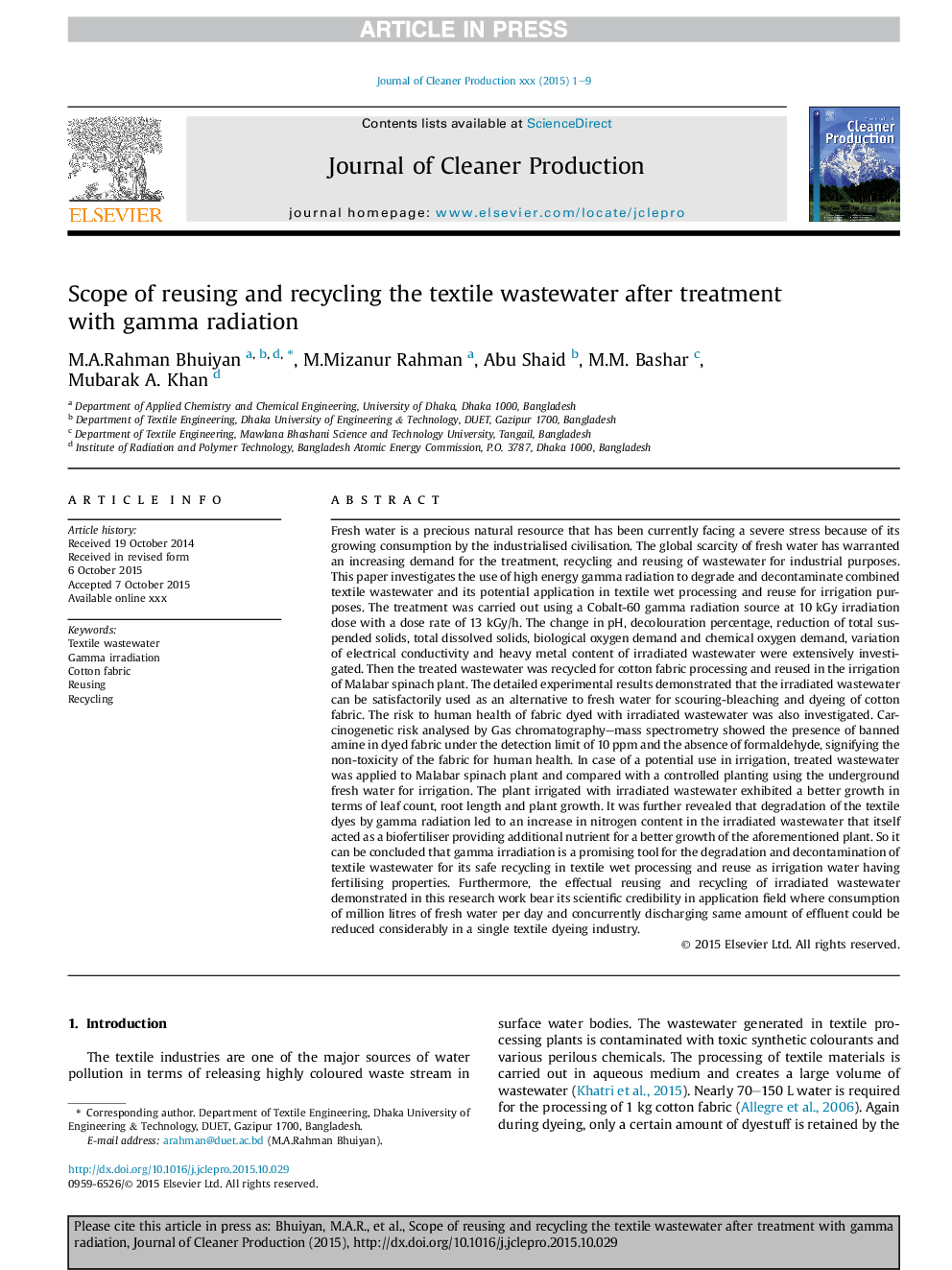| کد مقاله | کد نشریه | سال انتشار | مقاله انگلیسی | نسخه تمام متن |
|---|---|---|---|---|
| 10687892 | 1017962 | 2016 | 9 صفحه PDF | دانلود رایگان |
عنوان انگلیسی مقاله ISI
Scope of reusing and recycling the textile wastewater after treatment with gamma radiation
ترجمه فارسی عنوان
محدوده استفاده مجدد و بازیافت پساب فاضلاب پس از درمان با تابش گاما
دانلود مقاله + سفارش ترجمه
دانلود مقاله ISI انگلیسی
رایگان برای ایرانیان
کلمات کلیدی
فاضلاب نساجی، اشعه گاما، پارچه پنبه، استفاده مجدد بازیافت،
موضوعات مرتبط
مهندسی و علوم پایه
مهندسی انرژی
انرژی های تجدید پذیر، توسعه پایدار و محیط زیست
چکیده انگلیسی
Fresh water is a precious natural resource that has been currently facing a severe stress because of its growing consumption by the industrialised civilisation. The global scarcity of fresh water has warranted an increasing demand for the treatment, recycling and reusing of wastewater for industrial purposes. This paper investigates the use of high energy gamma radiation to degrade and decontaminate combined textile wastewater and its potential application in textile wet processing and reuse for irrigation purposes. The treatment was carried out using a Cobalt-60 gamma radiation source at 10Â kGy irradiation dose with a dose rate of 13Â kGy/h. The change in pH, decolouration percentage, reduction of total suspended solids, total dissolved solids, biological oxygen demand and chemical oxygen demand, variation of electrical conductivity and heavy metal content of irradiated wastewater were extensively investigated. Then the treated wastewater was recycled for cotton fabric processing and reused in the irrigation of Malabar spinach plant. The detailed experimental results demonstrated that the irradiated wastewater can be satisfactorily used as an alternative to fresh water for scouring-bleaching and dyeing of cotton fabric. The risk to human health of fabric dyed with irradiated wastewater was also investigated. Carcinogenetic risk analysed by Gas chromatography-mass spectrometry showed the presence of banned amine in dyed fabric under the detection limit of 10Â ppm and the absence of formaldehyde, signifying the non-toxicity of the fabric for human health. In case of a potential use in irrigation, treated wastewater was applied to Malabar spinach plant and compared with a controlled planting using the underground fresh water for irrigation. The plant irrigated with irradiated wastewater exhibited a better growth in terms of leaf count, root length and plant growth. It was further revealed that degradation of the textile dyes by gamma radiation led to an increase in nitrogen content in the irradiated wastewater that itself acted as a biofertiliser providing additional nutrient for a better growth of the aforementioned plant. So it can be concluded that gamma irradiation is a promising tool for the degradation and decontamination of textile wastewater for its safe recycling in textile wet processing and reuse as irrigation water having fertilising properties. Furthermore, the effectual reusing and recycling of irradiated wastewater demonstrated in this research work bear its scientific credibility in application field where consumption of million litres of fresh water per day and concurrently discharging same amount of effluent could be reduced considerably in a single textile dyeing industry.
ناشر
Database: Elsevier - ScienceDirect (ساینس دایرکت)
Journal: Journal of Cleaner Production - Volume 112, Part 4, 20 January 2016, Pages 3063-3071
Journal: Journal of Cleaner Production - Volume 112, Part 4, 20 January 2016, Pages 3063-3071
نویسندگان
M.A.Rahman Bhuiyan, M.Mizanur Rahman, Abu Shaid, M.M. Bashar, Mubarak A. Khan,
